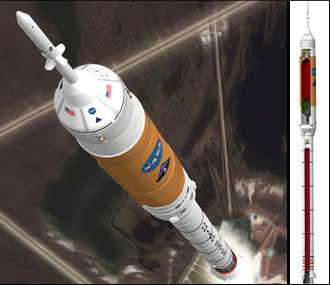A computer simulation of the planned Ares 1 rocket, which is supposed to put crew members into orbit around the Earth, showed that it could shake and explode during launch

The head of NASA, Michael Griffin, recently said that it is clear to him that a manned vehicle that is supposed to replace the space shuttle will present difficulties and challenges to the space agency's engineers. "NASA has an excellent past of overcoming technical difficulties and challenges, and I'm sure it will be the same in this case," Griffin noted in a conversation with the AP news agency.
The launcher "Ares 1" (Ares 1) is being developed as part of a program whose cost is estimated at one hundred billion dollars, and which will allow NASA to return to the moon with astronauts, in 2020. Remember, the last astronauts to visit the moon were the crew members of the Apollo 17 spacecraft, and that was in December 1972 .
The vibrations are supposed to be created as a result of the flow of hot gas from the rocket engine of the first stage of the Ares 1, 2 missile, and the concern is about their effect on what is in the upper part of the missile - and especially the manned "Orion" spacecraft. The vibration problem was identified by NASA and is common in solid fuel powered launch vehicles. The shock waves generated during engine operation may equal the natural resonant frequency of the rocket engine itself, and lead to extremely intense vibration, which in some cases can lead to the destruction of the entire missile.
NASA did not publicly address the vibration problems in the new rocket, until the AP News Agency made use of the Freedom of Information Act and forced NASA to respond. NASA engineers estimate that the danger of tremors is serious, and gave it a score of 5 out of 5 on the severity scale. Professor Fischenbeck stated that according to the information he has, the tremors are supposed to occur and this will lead to disaster, if they do not take quick steps to redesign the main components of the missile. The solid fuel engine of the Orion rocket will be built by ATK Launch Systems from Utah, USA, which built and continues to manufacture the solid fuel boosters for the space shuttles.
More of the topic in Hayadan:
The next fifty years in space
NASA has completed the survey of requirements for the Ares 1 missile
